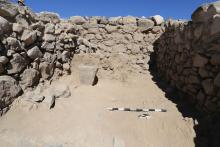By Kathryn Medill
Ancient Middle Eastern cultures like the Egyptians, Sumerians, Hittites, Israelites, and Babylonians were around long before the rise of the Roman Empire. Much of what we know about their lives was first discovered through archaeology.
Would you like to try volunteering at a summer archaeological excavation? Here’s an interview with two of our Hebrew Bible and Ancient Near Eastern Studies (HBANES) faculty, Stephanie Selover and Kathryn Medill, to tell you what to expect!
Where have you been digging, and what was your role in the excavations?
SS: I have excavated in Turkey, Jordan, Syria and Israel, as well as Italy and the US. I am currently the assistant director at Çadır Höyük in Turkey, and the field director at Khirat al-Balu'a in Jordan. I generally take 2 to 5 UW students to the field with me every summer.
KM : I’ve excavated at several locations in Israel as a volunteer.
What is a day on an archaeological dig like?
KM: We start early! At Azekah we got on the bus at our kibbutz before 5 AM and were carrying our gear from the dig’s storage shed to our areas as the sun came up. Our area directors, who were archaeology grad students, would assign us to different squares in teams of two. Sometimes we would be pickaxing and shoveling, trying to get through a packed floor; sometimes we would be working with mid-sized tools, collecting pottery and cleaning off stone features like walls and ovens; and sometimes we would break out the toothbrushes and finger picks to uncover something really delicate. Every hour or so everyone paused for a bucket line—digs generate a lot of dirt buckets! We would stop at 8:45 AM for a big dig breakfast. Between 12:00 and 1:00 we would head back to the bus. After getting back to the kibbutz, we would wash pottery for an hour before lunch. At many digs, there are lectures in the afternoon and field trips to other sites on weekends.
What’s something interesting that you found in your most recent dig season?
SS: At my site in Jordan, I am working on a large domestic structure that dates to about 800 BCE. This house is in a settlement of Moabites, an Iron Age people who are known from the Bible, but about whom we have only a small amount of archaeological knowledge. My students and I found a small room at the back of the house that appears to be a household shrine. The room contained a carved standing stone that was actually made of bedrock, meaning it was found in this place and carved, rather than moved here. Behind this standing stone was a mudbrick altar. Within the room were a number of religious artifacts, including small votive ceramics, clay goddess figurines, and a stone lion's head. This room will tell us more about worship within the domestic sphere of the Moabite people, something we know very little about!
KM: At Azekah we found a Middle Bronze destruction layer from c. 1450 BCE. There had been a collapse onto a cooking and storage area built against the outside of the city wall. We found a floor completely covered with broken pottery, including several large pink storage jars still full of barley, plus animal bones (probably from food animals and cuts of meat). There were two taboons, one still in use, and one inside a stone hearth that had later been built up and repurposed as a storage bin for more barley. We were taking the barley out in gallon buckets lined with foil!
What are your favorite and least favorite things about archaeology?
SS: I love being able to spend months in a country, really getting to know the language, food, people, culture and feel of an area. I am nearly always living in a small village. I also love that I get to share this with students, many of whom have never before left the US—and then have their first experience be not in a famous city, but in a place that few foreign people will ever visit. They really get to know what life is like there, as they meet new people and often form life-long friendships. I dislike the often large numbers of bugs, and sometimes how very hot it can be.
What’s a mistake you made in your early days with archaeology?
SS: In my very first excavation, when I was an undergraduate, I thought I had something to prove, so I spent my first day working as hard as I could, shoveling, pickaxing, and moving the biggest stones. I had never done work like that before, ended up dehydrated and passed out. Since then, I have learned to pace myself, and always watch carefully over my students to make sure that they don’t make my mistake. Archaeology can be a lot of fun, but it is also very hard work, both physically and mentally.
KM: On my second excavation, I was set to work in a square that included some cooking installations. I found a mudbrick circle and called one of the archaeologists over; he told me it was a taboon (a type of ancient oven) and that I should excavate it carefully. I had heard of taboons, but had never seen one. I had no idea that the bottom of the taboon was supposed to be lined with small stones, so I spent about an hour digging them out and throwing them away!
Who can go on a dig? How can students find one?
KM: Anyone can participate, from students to retirees! And people come from everywhere. At my last dig, most volunteers were from Israel, Germany, and Japan.
The American Schools of Overseas Research and Biblical Archaeology Society websites both keep lists of digs. (They both have funding available, too!) Or talk to us to get advice.
***
Check out upcoming HBANES courses here (Courses (washington.edu)) or on the MELC website.
